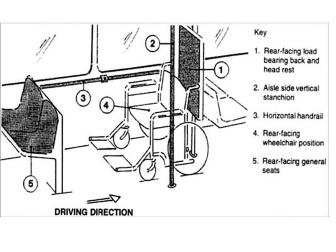|
This project investigated the physical response of occupied wheelchairs and the acceptance of wheelchair users of rear-facing containment on Bus Rapid Transit (BRT) vehicles. The concept is that wheelchairs can be safely transported using passive securement rather than active securement such as the belt systems currently in use by most transit agencies. The passive securement is accomplished by positioning wheelchairs in a location where their movement is constrained by the walls of a compartment.
This system was demonstrated and tested on transit buses of the Lane Transit District (LTD) located in Eugene, Oregon and at BC Transit in Victoria, British Columbia, Canada. In establishing the Expert Review Panel for this project, the investigators learned of an opportunity for research collaboration with BC Transit in Victoria. Additional data were collected on BC Transit buses that have rear-facing securement. The data collection in Victoria used the same protocols as those used in Eugene. The project determined that this type of rear facing wheelchair accommodation provides acceptable levels of comfort and safety for people in wheelchairs.
Completed Investigation
The project was done in three stages. Stage 1 included the field test preparation, the final approval, and permits for the field tests. Stage 2 included the tasks that are related to the field tests and analysis of the results. Stage 3 of the project included documentation of project activities, dissemination of results, technical papers, and the final report. This task also included the plan for transfer of the project results to practice.
Product Payoff Potential
It is anticipated that the results of this project will have a major impact on wheelchair accommodation on transit vehicles by providing more options for interior design of BRT vehicles in particular and of new transit vehicles in general. Finally, in the long run, it is anticipated that securement of wheelchairs on mass transit vehicles may become a nonissue for both the wheelchair users and the vehicle operators. This project provided information that could be useful in future review of the existing ADA requirements for bus rapid transit vehicles.
The principal result of the project determined the adequacy of rear-facing compartment securement systems. Specifically, the project determined that this type of passive securement will provide acceptable levels of comfort and safety for users of wheelchairs. In addition, the project resulted in knowledge of transit vehicle operating dynamics, the effect of those dynamics on passengers using wheelchairs, and detailed information that would justify less restrictive requirements for wheelchair accommodation on large transit vehicles.
Product Transfer
A number of transit agencies and federal agencies, such as the U.S. Department of Transportation, the U.S. Department of Justice, and the U.S. Access Board will benefit from the results of this research. The results of this research provide information that could be useful in future review of the requirements of the ADA concerning wheelchair orientation and securement for BRT vehicles. In addition, the U.S. transit industry as a whole will benefit from development of new approaches for wheelchair accommodation that promote the safety and dignity of travel for persons with disabilities and decrease dwell time at stations and bus stops.
As a follow-on to this Transit IDEA project, the research team at Oregon State University has actively assisted Lane Transit District (LTD) in Eugene, Oregon, with additional technical development of rear facing securement technology for the new BRT vehicle procurement. LTD and Cleveland Regional Transit Authority have purchased new buses that include rear-facing wheelchair securement positions, based on the results of this Transit IDEA project, in addition to front-facing securement. The first of these new buses at LTD entered service beginning in January 2007. Follow-on development activities on rear-facing securement have been conducted as a result of the testing activities that were done in this Transit IDEA project. Transit IDEA Project 57 will build on the results of this completed project. Additionally, the results of this project were the basis for a paper presented at the APTA Bus and Paratransit Conference in May 2006, which encouraged other transit agencies to seriously consider rear-facing wheelchair securement when purchasing new buses.

Figure 1
Sketch courtesy of Uwe Rutenberg.
NTIS PB #2005-107674
The final report for this IDEA project can be found at:
https://onlinepubs.trb.org/onlinepubs/archive/studies/idea/finalreports/transit/Transit38_Final_Report.pdf.
|
|